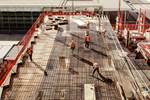ACI publishes code requirements for GFRP rebar
New comprehensive building code requirement covers the use of nonmetallic, GFRP reinforcing bars in structural concrete applications that are covered by ACI 318-19.
Photo Credit: Getty Images
The (ACI, Farmington Hills, Mich., U.S.), through the work of ACI Committee 440, has released . The code was developed by an ANSI-approved consensus process and addresses structural systems, members and connections, including cast-in-place, precast, non-prestressed and composite construction.
This is reported to be the first comprehensive building code covering the use of nonmetallic, GFRP reinforcing bars in structural concrete applications. GFRP reinforcement has been in use for decades as an alternative to steel reinforcement because of its non-corrosive, non-magnetic and lightweight properties. According to ACI, this code represents a milestone for this technology, and mirrors ACI 318-19 with provisions for designing GFRP-reinforced concrete beams, one-way and two-way slabs, columns, walls, connections and foundations. Other model codes and standards can directly reference ACI CODE-440.11-22 to enable widespread, responsible use of this important technology.
“What really sets this code apart is that it is dependent on ACI 318-19,” Will Gold, past chair, ACI Committee 440, says. “With this new code, almost almost any structural element covered by ACI 318 can be designed using GFRP reinforcement instead of steel reinforcement. A great deal of new research and validation was required for the code to address elements such as connections and columns. The hard work and efforts of many ACI Committee 440 members made development of this new code possible, and it represents a tremendous accomplishment by the committee.”
ACI Committee 440’s mission is to develop and report information on fiber-reinforced polymers (FRP) for internal and external reinforcement of concrete. Committee 440 has written and maintains a number of design guides, materials and construction specifications, reports and technical notes on the use of FRP in structural concrete applications.
Related Content
-
Plant tour: Teijin Carbon America Inc., Greenwood, S.C., U.S.
In 2018, Teijin broke ground on a facility that is reportedly the largest capacity carbon fiber line currently in existence. The line has been fully functional for nearly two years and has plenty of room for expansion.
-
Development of a composite liquid hydrogen tank for commercial aircraft
Netherlands consortium advances cryogenic composites testing, tank designs and manufacturing including AFP, hybrid winding, welding of tank components and integrated SHM and H2 sensors for demonstrators in 2025.
-
Low-cost, efficient CFRP anisogrid lattice structures
CIRA uses patented parallel winding, dry fiber, silicone tooling and resin infusion to cut labor for lightweight, heavily loaded space applications.



